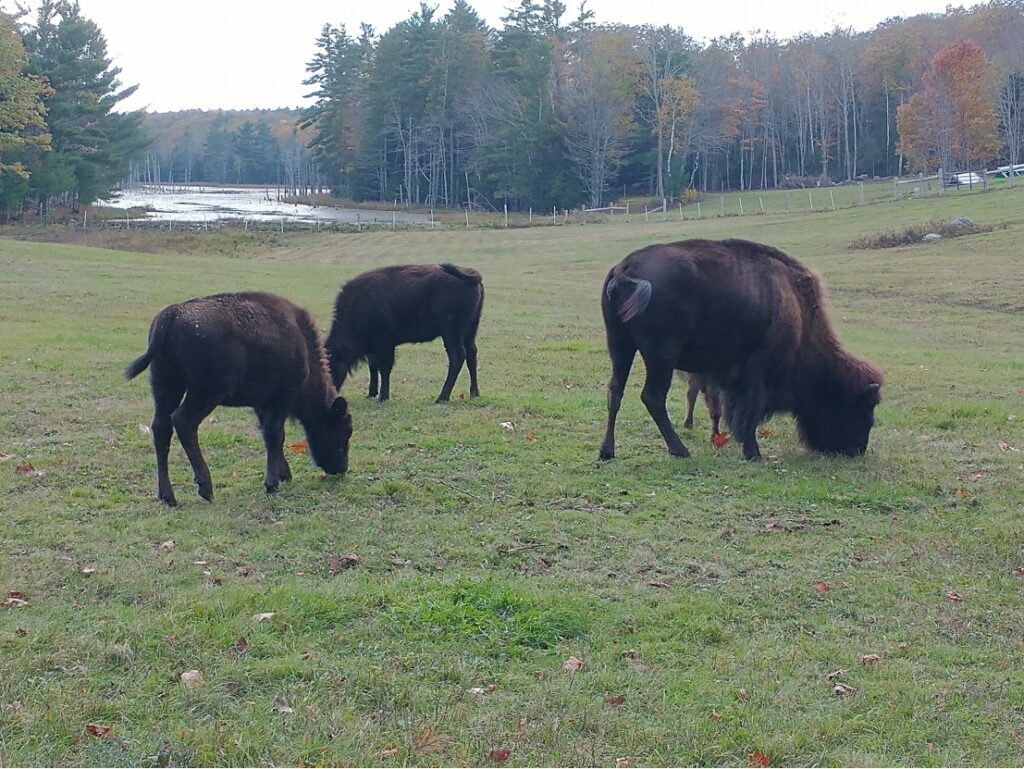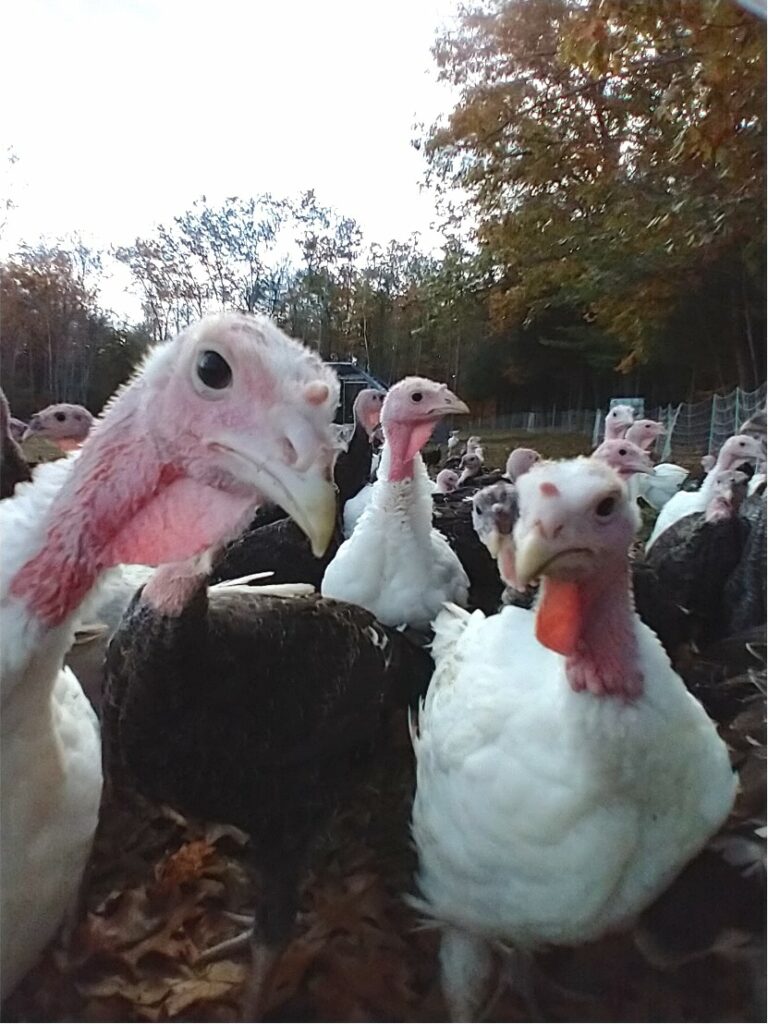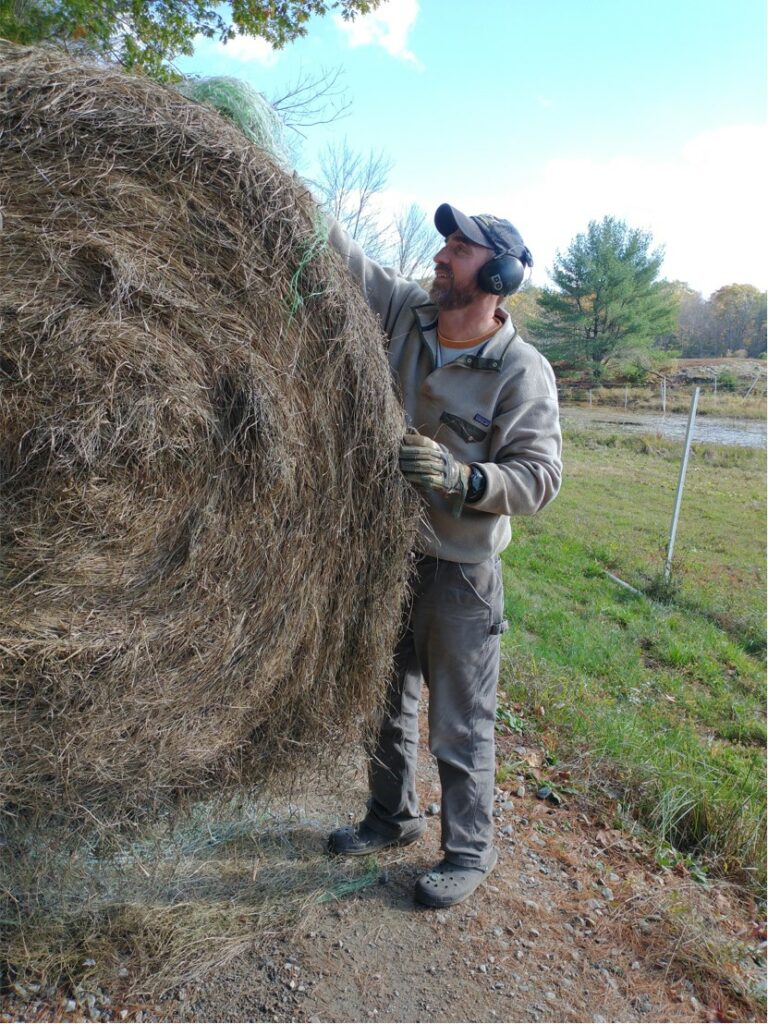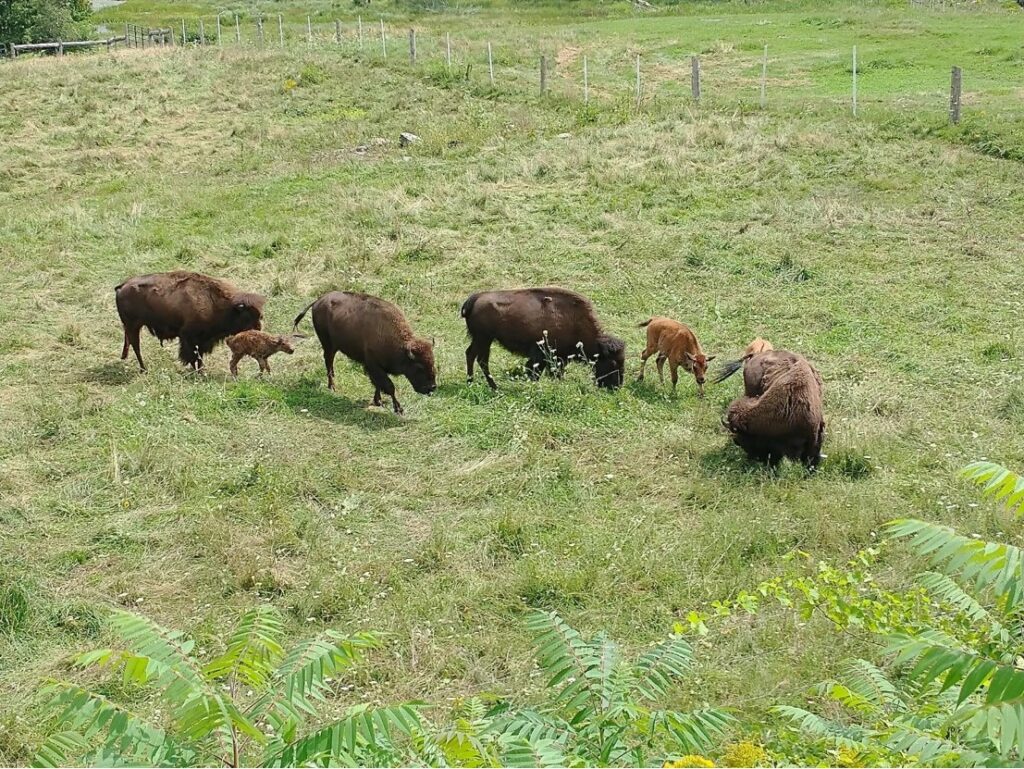By Sonja Heyck-Merlin
“We can’t get close enough to see the calves,” says Keith Radonis. “We use binoculars to investigate, and we think it’s two females and a male, but we’re not sure.” Scientifically speaking, these calves — the first to be born at Flying Boat Farm in Whitefield, Maine — are bison, not buffalo. Though the words buffalo and bison are used interchangeably and both are in the Bovidae family, the two species are not closely related.

Native to Africa and Asia, the “true” buffalo species are Cape buffalo and water buffalo. Bison, on the other hand, are native to Europe and North America. The Bovidae family also includes antelopes, sheep, goats, muskoxen and domestic cattle, for some perspective on how vast the Bovidae family is. According to the U.S. Department of the Interior, historians believe the use of the word buffalo grew from the French word for beef — “boeuf.”
Taxonomically speaking, these calves are Bison bison bison, a subspecies of Bison bison. Commonly, they are known as plains bison. The other subspecies, wood bison or Bison bison athabascae, is an endangered species living in the boreal forest regions of Alaska and Canada.
“Bison have not had their wild nature bred out of them,” Keith says. “They’re massive animals, the largest land animals in North America, who can run as fast as a horse and jump 6 feet from a standstill. When they are left alone, they thrive. The more you handle them, the more stressed they become.”
According to Dr. Jeff Martin, a vertebrate paleontologist, wildlife scientist and the director of research for the Center of Excellence for Bison Studies at South Dakota State University, the academically accepted common ancestor of all Bovidae species is the auroch. Aurochs, now extinct, are a wild cattle species that inhabited Asia, Europe and North Africa, dating back two million years.
About 300,000 years ago, bison species arrived in Alaska, via the Bering Land Bridge, and remained there for about 140,000 years. When the Laurentide Ice Sheet, covering most of Canada, and the Cordilleran Ice Sheet, located mostly in the Canadian Rocky Mountains, retreated from one another, it opened up what is referred to as the Ice-Free Corridor in modern-day Alberta and Yukon Territory. Using the corridor, bison began to populate the rest of North America.
“There were several different waves of genetic lineage percolating into North America,” Martin says. Though one of these species, Bison antiquus, was thought to be an extinct species, current scientific understanding is that the plains bison on Flying Boat Farm are direct descendants of B. antiquus.
Keith, who moved 18 times during his 22 years of service as a navy pilot, retired in 2018. When he was serving at the Naval Air Station Brunswick (BRAC) during the midpoint of his career, he met his wife Valori, who grew up on a hobby farm in Auburn, Maine. As Keith’s retirement approached, they were stationed in Virginia and began contemplating a transition to agriculture. “It might have been a magazine with a bison on the cover and the fact that we liked the meat that got us interested in bison farming,” says Valori. Their dream solidified as they learned more about bison and their history, including helping out on some ranches in Virginia and attending the International Bison Conference in Big Sky, Montana.
To begin their herd, Keith and Valori purchased four bred heifers. This was possible due to what Keith describes as “one of the greatest conservation successes in U.S. history.”
In the mid-1880s, at the beginning of western colonial expansion, the estimated bison population was 30 to 60 million head, extending from Canada and into northern Mexico. “With this expansion,” says Martin, “came disease, railroads and bullets.” By the turn of the 20th century, the bison population had declined to less than 1,000. According to the Montana-based nonprofit Buffalo Field Campaign, this decimation was a gradual process, though in the 1870s more buffalo were killed than in any other decade in history. The animals were killed mainly for their hides and tongues, which were shipped to markets in the East. The bones were ground for fertilizer and used to whiten bone china.
Martin says that only seven to eight million of the deaths can be attributed to hunting. “We know how many hides were sold through New York and how many bullets were manufactured. It’s impossible for bullets to be the primary cause of death,” he says. In 2019, a paper was published in the Society for Range Management that hypothesized Texas tick fever — spread to bison from colonizers’ cattle during cattle drives from Texas into the northern grasslands — might have played a substantial role in the near extinction of the bison.
The calamitous decline of the bison also devastated the lives of Indigenous people. For thousands of years, Indigenous people of the Americas and bison were inextricably connected, as captured by text from the intertribal Buffalo Treaty of 2014:
“Since time immemorial, hundreds of generations of the first peoples of the First Nations of North America have come and gone since before and after the melting of the glaciers that covered North America. For all those generations Buffalo has been our relative. Buffalo is part of us and We are part of Buffalo culturally, materially, and spiritually. Our ongoing relationship is so close and so embodied in us that Buffalo is the essence of our holistic eco-cultural life-ways.”
The treaty, initiated by Indigenous people, works to recognize the significance of the bison to their cultures while also creating an alliance to restore bison to 6.3 million acres of tribal and non-tribal land in the United States and Canada — all of which was stewarded by native people before colonial settlers arrived in the region. An op-ed co-authored by members of the Blood Tribe, Blackfeet Nation, Intertribal Buffalo Council (ITBC), Piikani Tribal Council and Fort Peck Tribal Council, and published in Live Science in 2014, called the egregious treatment of bison “the great slaughter of the 19th century” that “led to deterioration of the ecological integrity of grasslands, diminished the health of our people, and led to an incalculable cultural loss.”
The op-ed credits early conservation efforts made by Theodore Roosevelt, William Hornaday, Ernest Thompson Seton and others with bringing bison back from the brink of extinction.

Martin says that conservation efforts began as early as the 1880s when individuals started fencing bison onto private property. Eventually, they started selling animals and this facilitated the spread of bison throughout North America. In 1894, the first federal legislation — The Lacey Act of 1894 — prohibiting poaching of bison within national parks was enacted, imposing fines of up to $1,000 (equivalent to $27,500 in 2015).
“The recovery of the bison population is a remarkable story,” Keith says. “The bison went from near extinction to its current population of nearly a half-million animals, which includes the United States, Canada and Mexico.” (Martin says this number is closer to 400,000.)
When Keith and Valori moved to their land in 2018, ready to implement their five-year plan to introduce bison, there was no grass to speak of in their 25 open acres. “Though it was once a farm, the land hadn’t been worked in 50 years. The soil was acidic — great for growing blueberries and cranberries, but not grass,” Keith says. Bison are herbivores, feeding primarily on grasses and forbs (broadleaf plants that are not grass-like).
Knowing that they eventually wanted to rotationally graze their bison, mimicking the migratory behavior of the wild bison across native grasslands, Keith and Valori reached out to Natural Resources Conservation Service (NRCS) and MOFGA. The organizations helped them evaluate what grasses they had and what they could do to bring them back and shared pasture management techniques. Valori also attended Armed to Farm, a hands-on sustainable agriculture training for military veterans and their family members.
In their first growing season, Keith and Valori started to regenerate 2 acres of pasture, first by adding goats, who browsed the leafy growth. Then they used 30 KuneKune pigs and American Guinea Hogs, followed by 30 turkeys to aerate the soil and also provide additional fertility. These small breeds of pigs, one of which is native to New Zealand (the Kune Kune), grazed without disrupting the soil, says Keith.
“It’s amazing how our pastures changed during that first growing season,” Keith says. “The next year we added some acreage and the grass really began to grow. Our third year, we increased the number of turkeys to 60. We slowly became turkey farmers as we were preparing to become bison farmers.” By the end of the second growing season, they had about 10 acres of improved pasture.

As the goats, pigs and turkeys rotated through paddocks divided by portable electric fencing, the farmers began building a fencing system in anticipation of the bison. The perimeter fence is 6 feet high with seven horizontal strands of high-tensile wire. It’s divided into four sections with 4-foot-high wire with five horizontal strands. Many of the 10-inch cedar posts that support the wire needed poured cement foundations. Keith jokes, if we were farming granite, we would be millionaires.
Though they were working from a five-year plan, the improvement of their pastures was such that they were ready to acquire four bred bison in 2021, their third growing season. The animals came from a conventional bison farm in Connecticut and because the mothers were managed organically from the last third of their pregnancies, the calves are certified organic. One calf was stillborn, so the current herd size at Flying Boat Farm is seven.
Two of the four paddocks are about 2 acres, providing enough grass for about three weeks. The other two are closer to 5 acres and each provide about 45 days of grazing. With this rotation, each paddock has a 90-day rest period, which is enough to break the parasite cycles of coccidia, giardia, cryptosporidium, etc. During the rest periods, Keith mows the weeds, mostly ragweed and thistle, with a bushhog pulled by a John Deere 5300.
According to Martin, cattle are energy maximizers, meaning they hunker down in their favorite spot and graze with little movement. Bison, on the other hand, are time minimizers. “They eat a patch as they’re walking and move all over the place. This trait has been bred out of beef cattle. Bison, not being domesticated, exhibit these wild behaviors. Essentially, they’re a sitting duck for predators if they don’t move,” Martin says.
Each of Flying Boat’s four pastures is large enough to support this behavior. The size also means that Keith rarely needs to enter the fenced-in area, which is important given the fact that bison have large flight zones — the distance within which a person can approach an animal before it moves away. Keith and Valori do not intend to handle the three calves until it is time to process them for meat at age 2.
Though they are not native to Maine, bison thrive in the cold weather and, other than a windbreak, they don’t require indoor housing. Keith says the beautiful humps on their backs can be attributed to muscle development from using their heads as plows as they push away the snow and search for grass.
The closest Keith gets to the bison is during the winter when he brings a round bale of dry hay (purchased from a local, organic farm) into one of the paddocks. He keeps these trips as short as possible. “Even when you are in the field and 250 yards away, they are watching. Just outstretching your arms like you do in a jumping jack is enough to make them move. That’s how skittish they are and how much they desire to be left alone,” says Keith.

Despite the unpredictable nature of the animals, Keith and Valori feel confident that they can keep themselves and their three children — ages 8, 13 and 14 — safe. Their primary focus is now on the bison, and though they still plan to raise about 120 Thanksgiving turkeys annually, they sold the goats and will only raise two pigs per year. Short-term plans include finding a bull, building a handling facility and expanding their pasture system. “We would like to incorporate some silvopasturing,” Keith says. “Bison really love the forest.”
In 2016, the National Bison Legacy Act was signed, officially making bison the national mammal of the United States, the first such designation for a mammal. Each year, the first Saturday in November is designated as National Bison Day. Conservation efforts continue to this day. Martin says, “The continued success story is attributable to the collaboration of government, tribal groups, private ranchers, and not-for-profit NGOs, also known as the Bison Management System.” Keith and Valori are grateful to play a role and are particularly proud of their organic certification.
“As far as we know, we’re the only certified organic bison farm in Maine and on the East Coast. With good organic practices — pasture management and low-stress handling — hopefully we’ll make a go of it,” say Keith and Valori.
About the author: Sonja Heyck-Merlin is a regular feature writer for The MOF&G. She and her family own and operate an organic dairy farm in Charleston, Maine.
